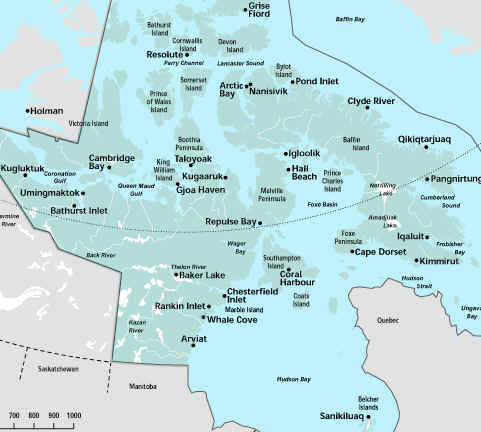|
The Creation of Nunavut
On April 1, 1999, the map of Canada significantly changed for the first time
since Newfoundland joined Confederation in 1949. The Northwest Territories was
divided into two parts with the creation of the new territory of Nunavut in the
east. It has been said that the sign of a healthy federation is its ability to
grow and evolve over time in order to accommodate the changing aspirations and
wishes of its citizens. By these criteria the Canadian federation is indeed
healthy. For the first time in fifty years the map of Canada was redrawn, not as
a result of conflict, but peacefully and democratically.
The territory of Nunavut (which means "our land" in
Inuktituk) stretches some 1.9 million square kilometres. This is an area larger
than Newfoundland, Prince Edward Island, Nova Scotia, New Brunswick and Quebec
combined. The population of the new territory is approximately 24,000, of whom
85% are of Inuit origin (18,000). The creation of Nunavut demonstrates the
collective commitment of Canadians to enable Inuit, and other residents of the
eastern Arctic, to take charge of their own destiny.
The Nunavut

The Road to Territorial Status
The road to the creation of Nunavut was a long and winding one. The idea of
dividing the NWT into two parts was first discussed in the early 1960s. It was
the residents of the western part of the territory who initially broached the
subject. Many believed that two smaller territories would be easier to govern
than one geographically expansive territory. It was argued that division would
help accelerate political development in the North and ultimately bring about
increased self-government.
Prior to the 1950s, it was the federal government that directly administered
the NWT. The head of government in the North was an Ottawa-based Commissioner
who presided over a Territorial Council that was also appointed by Ottawa. It
was not until 1951 that the first election was held for a seat on the Council.
Gradually more elections were held. It was not until 1975, however, that all
representatives of the Council were elected.
In 1966, the federal government established the Carrothers Commission to look
at the issue of government in the North. After extensive study and consultation,
the Commission concluded that division of the NWT was probably both advisable
and inevitable. There was a recognition that Northerners wanted to run their own
affairs and must be given the opportunity to do so. At the same time, however,
it noted that governmental reform was required before this could happen. It
recommended the establishment of a new system of representative government. As a
result, in the late 1960s and in the 1970s, the federal government gradually
created electoral constituencies and transferred many federally run programs to
the territorial government. Northerners took on more and more responsibility for
the day-to-day running of their own affairs.
In 1982, a plebiscite was held in the NWT asking the question, "Do you
think the NWT should be divided?" Fifty-three percent of eligible voters
participated in the plebiscite, with 56.4 percent of them voting
"yes." Voter turnout and support for division was particularly strong
in the Eastern Arctic. The Inuit population of the eastern section of the
territory had become increasingly receptive of the idea of self-government. It
was viewed as the best way to promote and protect their culture and traditions
and address their unique regional concerns.
Both the NWT Legislative Assembly and the federal government accepted the
idea of dividing the territory. The idea was viewed as an important step towards
enabling the Inuit, and other residents of the Eastern Arctic, to take charge of
their own destiny. There were some reservations, however. Before action could be
taken, certain practical considerations had to be addressed. First of all,
outstanding land claims had to be settled. Second, all parties had to agree on a
new boundary. Finally, all parties had to agree on the division of powers
between territorial, regional and local levels of government. The various
governments and native groups worked closely together to realize these goals.
The Nunavut
Land Claims Agreement was ratified by the Inuit in November of 1992,
signed by the Prime Minister of Canada on May 25, 1993, and passed by the
Canadian Parliament in June of the same year. It was the largest native land
claim settlement in Canadian history. It gave the Inuit title over 350,000
square kilometres of land. It also gave the Inuit capital transfers from the
federal government of over $1.1 billion over the next 14 years. This money will
be held in trust with the interest to be used in a variety of different
projects, including financing for regional businesses and scholarships for
students. The Inuit also gained a share of resource royalties, hunting rights
and a greater role in managing the land and protecting the environment. The land
claims agreement also committed the Government of Canada to recommend to
Parliament legislation to create a new territory in the eastern part of the
Northwest Territories.
While negotiations on a land claims settlement progressed, work was also
taking place to determine potential jurisdictional boundaries for a new Eastern
Territory. A proposal was presented to all NWT voters in a May 1992 plebiscite.
Of those voting, 54 percent supported the proposed boundary. The Government of
the Northwest Territories, the Tungavik Federation of Nunavut (the Inuit claims
organization) and the federal government formally adopted the boundary for
division in the Nunavut Political Accord.
The final piece of the equation fit into place on June 10, 1993, when the Nunavut
Act received Royal Assent. It officially established
the territory of Nunavut and provided a legal framework for its government. It
fixed April 1, 1999, as the day on which the new territory would come into
existence.
For general information see:
(Text prepared by Intergovernmental Affairs, Privy Council Office)

|



